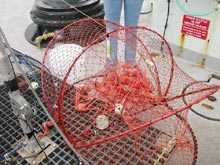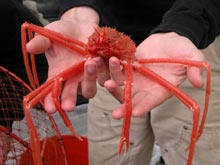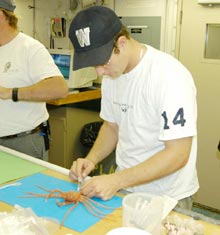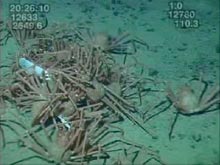Deep-sea Spider Crabs: Behold! The Crimson Hue
August 20, 2004
Matt Richards
Western Washington University
![]() See how spider crabs, Macroregonia macrochira, were collected from a depth of 2,900 m on Pratt Seamount. (mp4, 5.7 MB)
See how spider crabs, Macroregonia macrochira, were collected from a depth of 2,900 m on Pratt Seamount. (mp4, 5.7 MB)
Found in water 900-3000 m deep, the deep-sea spider crab, Macroregonia macrochira, is most abundant around a depth of 3,000 m. The wide ranges of depths at which these crabs can live makes them unique, and they may have several physiological adaptations that make them well suited for the extreme conditions at depth, including inflated brachial chambers, elongated legs, and bright red color.
We take several measurements and samples from each crab we collect. We measure carapace (shell) length and width, and claw height. (Claw height serves as an indicator of maturity and tells us whether the crab is a juvenile or adult.) We dissect the crabs to look at gonad size and color to determine reproductive potential. During the dissection, we will also take a gill sample for DNA analysis.

We lower a metal platform, called an elevator, loaded with freshly-baited crab traps down to the sea floor in order to catch deep-sea spider crabs. Most of the crabs captured here were juveniles. This is great for our study, because the hormone levels will span a wider range giving us more insight into growth and reproduction. Click image for larger view.

Deep-sea spider crabs, like this one, have long, spider-like legs and are a brilliant red. The crabs we collected had an average carapace length of about 62 mm and an average width of about 53 mm. We only caught three crabs that we think were mature adults; they were around 85mm in length and 73mm in width. Click image for larger view.
Blood samples also give us additional insight into growth and reproduction by enabling us to measure hormone levels and to study growth potential. Crabs must molt, or cast off their old shell, in order to grow. Ecdysteroids are hormones that control the molting process and the regeneration of lost limbs. These hormones also play a role in reproduction; and blood levels of these hormones are high during egg development and decrease after egg extrusion. Thus, we can predict when a crab will molt and assess where it is in its reproductive cycle by studying its hormone levels.
We will be using an enzyme-linked immunosorbent assay (ELISA) to determine hormone levels from the blood samples we collect. I expect the deep-sea spider crab to have lower hormone levels compared to other species of Majidea (spider) crabs that are found at shallower depths because of the lower availability of food in the deep sea. The reason for this is crabs are unable to produce sterols, which are key building blocks for the production of ecdysteriod hormones, so cholesterol (a type of sterol) is an important factor in crabs diets. Reduced food availability means lower cholesterol in-take, which in turn manifests as a lower concentration of ecdysteroid hormones in the blood.

Blood samples, like this one, that we take from deep-sea spider crabs enable us to study hormone levels that help us understand growth and reproduction cycles. Click image for larger view.

This red, sausage-sized structure is the external portion of an unusual, parasitic barnacle, Briarosaccus callosus, found on many species of king crabs. Here the barnacle is parasitizing a scarlet king crab, Lithodes couesi, collected on Pratt Seamount. The parasite sterilizes its hosts and uses their energy to produce hundreds of thousands of barnacle larvae, which closely resemble the larvae of the more typical acorn barnacles. One of the many unusual features of the barnacle is its bright red color, caused by hemoglobin. The barnacle also induces its crab host to protect it and assist with larval release. Click image for larger view.
Armed with this understanding, we will be able to learn a lot about deep-sea spider crabs from the blood samples we have collected on this cruise. Our findings may even help us understand more about the two commercially important species of spider crabs, the tanner and snow crabs.
Sign up for the Ocean Explorer E-mail Update List.

























